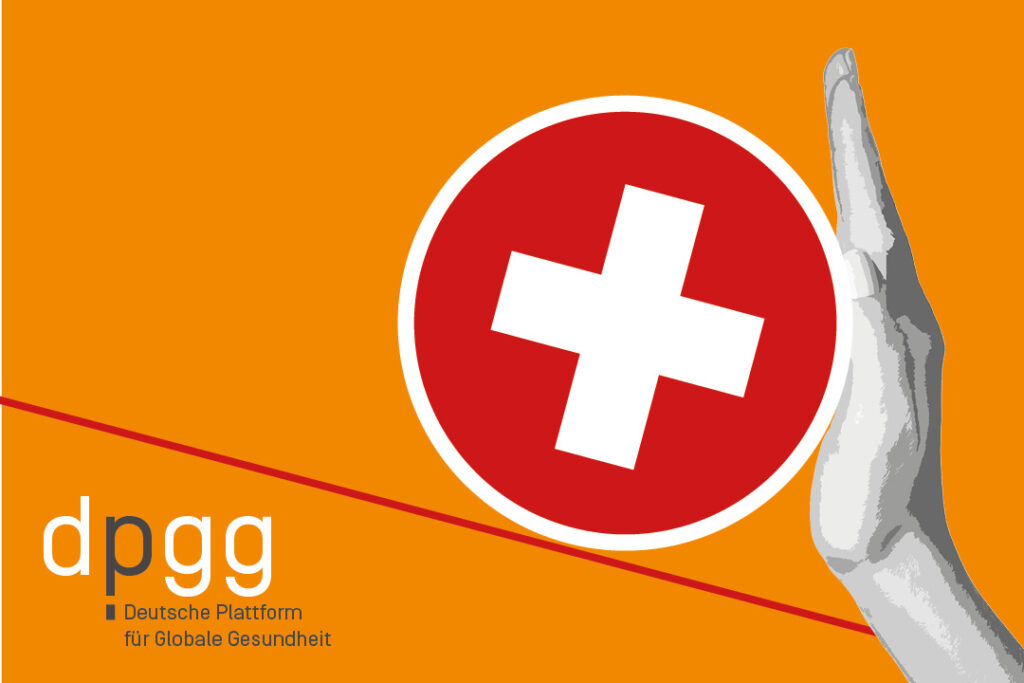by Tea Bosso and Guiseppe Bartolomei
Der Text stellt eine Dokumentation des Panelbeitrags der beiden italienischen Ärzt*innen Tea Bosso und und Guiseppe Bartolomei dar, den sie im Rahmen des Gesundheitspolitischen Forums 2024 zur Frage “Was ist rechte Gesundheitspolitik” gehalten haben. Eine deutsche Übersetzung findet ihr in der Gesundheit braucht Politik 4/2024. Wir danken den Autor*innen, dass sie sich für uns mit dieser Frage auseinandergesetzt haben und unsere Diskussion um ihre fundierte Perspektive bereichert haben.
Content
- Introduction
- Presentation and main issues of Italian NHS
- Examples of right-wing policies
- Conclusion
1. Introduction
Medical Staff Strike: Reasons and Data
On Nov. 20, a strike called by medical staff took place against the budget law dubbed “the worst in 30 years,” which includes cuts in resources for staff and health services. The protest, which was joined by 85 percent of working union member physicians, denounces the trend of favoring profit and the private sector at the expense of public health care.
A survey on more than 4,200 physicians revealed some significant data:
- 72 percent of physicians would choose the profession again, but only 28 percent would continue to work in the public sector.
- 73% of respondents work more than the 38 hours per week stipulated in the contract.
The condition of nursing staff is perhaps even worse: in 2023, some 130,000 aggressions (physical and verbal) against nurses were recorded, a dramatic sign of the difficult working conditions.
- Added to this is a structural shortage of nurses: there is a shortage of at least 175,000–220,000 nurses compared to European standards. Every year about 8,000 nurses voluntarily leave the public sector, while in the past decade about 50,000 nurses have left Italy, with more than half of them not planning to return.
The strike was called to raise awareness of the real causes of daily inefficiencies: cuts in staff and health care facilities, which have drastically reduced health care delivery. The protest also highlights the lack of incentives to retain doctors and nurses in the NHS, who are increasingly attracted to the private sector and abroad. It seems to us, however, that the problem goes far beyond the economic conditions of the staff! At this respect, we would briefly introduce you thee organization NHS focusing on the more problematic aspects.
2. Presentation of the Italian Health Service
The Italian healthcare system, Sistema Sanitario Nazionale (SSN), is a universal and comprehensive service designed to provide medical care to all Italian citizens and residents. Established in 1978, it is funded primarily through taxation. The SSN offers a wide array of healthcare services, encompassing hospital care, outpatient services, specialist consultations, and prescription medications. It should be structured to ensure that healthcare is accessible to everyone, regardless of their financial situation, embodying the principles of universal coverage. Unfortunately, this is not the case anymore (if it ever was). Some major reforms in SSN during the last decades are listed here, for their relevance in the actual crisis:
2.1 Corporatization
Another issue is the trend toward “corporatization”; where hospitals and healthcare facilities are transformed into semi-autonomous entities with greater administrative independence. While presented as a way to improve efficiency, it has led to variations in the quality of care and resource allocation between regions and to an overall worsening of health care services.
The idea of corporatization in the health care sector took shape in our country in the late 1980s and came to fruition with the reforms of 92–93 and 99 (center-left governments), influenced by neoliberal theories. These, denigrating public service and work, exalted the efficiency of the private sector and the managerial logics of New Public Management, with the intention of reducing the role of the public entity. However, corporatization has not produced tangible results in terms of efficiency and optimization of NHS resources.
In general, corporatization has turned health care into a commodity (commodificaton),giving a price to every serviced offered. In so doing, NHS comes to be no different from any other service company.
2.2 Regionalization
We have to take into account that Italy is composed of 21 regions. The regionalization of health care is the process that followed constitutional reform (2001, left-center government) and saw Italian regions gain increasing autonomy in the management of health care services. The stated goal was to improve the efficiency and adaptation of health services to the specific characteristics of each region, but this process also led to some inequalities in levels of care between different areas of the country.
Main impacts of regionalization:
- Disparities between regions: Although the idea was to ensure universality and equality of care, regionalization has created significant differences in health services between different areas of the country, particularly between the North and the South. Wealthier regions (e.g., Lombardy, Veneto, Emilia-Romagna) have been able to ensure higher quality and quantity of health services, while poorer regions (such as those in Southern Italy) often struggle to ensure high standards due to limited resources. For example/ Statistical studies (Agenas, 2024) show a North-South gradient to the disadvantage of southern regions for outcomes after ischemic stroke, or for different types of interventions-ex. deliveries by cesarean section, interventions for femur fracture in patients over 65 operated within 48 hours, thrombolysis for ischemic stroke.
- Different regional health care systems: Each region has some freedom in organizing and managing its network of health care services. As a result, some regions have adopted innovative models and good practices, while others have seen less effective management, with greater difficulty in ensuring compliance with national standards.
- Essential Levels of Care (AHPs): To ensure that all regions provide a minimum level of health care, the central government introduced the Essential Levels of Care (AHPs), which establish the health care services that must be guaranteed to all citizens, regardless of the region in which they live. However, the evaluation and delivery of the LEAs also depend on local resources and regional management.
- Financing system: Regions are responsible for the health budget, but the central government has a role in controlling spending and determining annual funding. The distribution of these resources is often tied to performance indicators that assess the effectiveness and efficiency of health care management in different regions.
2.3 Hospital versus community care
Responding to economic needs, Local Health Authorities grow bigger and bigger, this resulting in an ever decreasing proximity of the health service to people. We see a significant disempowerment of territorial medicine, based on the concept of health care provided exclusively by acute hospital settings, on the one hand, neglecting the importance of prevention and, on the other hand not providing adequate support of the patient in the post-intervention (discharge). This situation is the result of a cost rationalization that leads to the emergence of (hospital) centers of excellence within an otherwise under/ resourced territory.
2.4 Privatization
The next step, intrinsically related to corporatization, has been to gradually transfer functions and activities that previously were hold by the public directly to private companies: not only in the final delivery of care, but also in the training of health care personnel, research, and even regulatory activities.
Nowadays, almost half of the hospital facilities, about 60% of outpatient facilities, over 80% of residential and semi-residential facilities (including rehabilitation) for non-acute patients; and practically all home care services are in the hands of private companies.
This general process of applying neoliberal policies to health care has been applied continuously (with the sole exception of the years of the covid-19 pandemic) by all the governments from the 1990s until now. Meloni government’s budget law, which includes further cuts, also moves in this direction, without any significant changes.However, if we take some more specific examples, and in particular if we move from national to regional policies, we can observe some trends that might indicate a specificity of far-right governments.
3. Right wing government politics
3.1 Reproductive health and Bioethics
The first example of far right policies in health regards reproductive rights and abortion.
A first hint of Meloni government consideration of aborion rigth can be the fact that the government had not submitted the usual annual report on the implementation of Law 194 (Law on Voluntary Termination of Pregnancy), a gap that had not happened for 46 years. The most recent report, published in October 2023, referred to data for 2021, and thus did not reflect the current situation.The delay raises questions about a possible political will to withhold current data, particularly in light of the Meloni government’s deterrence policies regarding the right to abortion.
We have to recognise some structural difficulties, independent of government political orientation, that hinder the implementation of Law 194 such as the high number of conscientious objectors (63.4 percent of gynecologists, 40.5 percent of anesthesiologists, and 32.8 percent of nonmedical personnel). Nevertheless, the deterrence policies implemented by the right-wing government and regions are a crucial element in limiting access to abortion.
Some iniziativee produce a general atmosphere against the very idea of abortion rights: examples of that kind are the “motions for life,” which enshrine municipalities that sign them as cities in the forefront of “abortion prevention and maternity support”;or the creation fetus cemeteries, with the names of women who had abortions displayed on fetus gravestones, as happened in Rome; or the attempt to introduce the obligation to bury fetuses even without the woman’s consent.
Far more incisive, however, are regional policies: many right-wing local government directly fund “pro-life” associations, active against the right to abortion. Piedmont, our region, led the way by giving 1.5 millions to anti/abortion associations which then distribute a small economic aid to women who renounce abortion. Umbria followed with the same fund, “against the demographic winter.” In Lombardy, with a resolution of the Regional Council promoted in 2000, “accredited private family counseling centers can exclude from the services rendered those provided for the voluntary interruption of pregnancy,” legitimizing, in fact, the structure objection prohibited by Law 194. In the Marches, in 2023, the region’s 66 consultation centers are open an average of 11 hours a week.
Also, all sorts of obstacles to the administration of the abortion pill, Ru486, rises in far right regions : in the Marche region, for example, it has been prohibited, in open contrast to national guidelines.
In sum, the abortion situation in Italy is characterized by deterrence policies that, without formally modifying Law 194, hinder its application, fostering the growth of conscientious objectors and limiting access to pregnancy termination services. In addition, right-wing regional policies, such as those in Piedmont, aim to reduce access to abortion through public funding of anti-abortion initiatives.
Surrogate motherhood
Keep talking of on the reproductive health theme, on Oct. 16 the Italian Government passed a law strengthening the ban on surrogate motherhood, making it illegal even abroad. The law was sought by the far-right Fratelli d’Italia party of Prime Minister Giorgia Meloni, who calls herself a “Christian mother.”
According to the previous legislation, those who avail themselves of surrogacy in Italy face a prison sentence betweenthree months and two years and a fine of up to 1 million euros. Until now, however, Italians could go to countries where the practice is legal, including the United States and Canada. With the new law, surrogate motherhood becomes punishable even if practiced abroad, in countries where it is legal and regulated.
Certainly the issue of surrogate mtherhood raises many ethical questions that should be discussed, however, it seems to us that this criminalization aim to shrink the rights of non traditional family. It is a health policy based on a precise idea of what form the “healthy” family should take.
End of life
Parallel to policies on birth control, there are those relating to end-of-life. In this context, we report a case of open conflict between the government and the region of Emilia-Romagna. In April of this year, the Presidency of the Council of Ministers and the Ministry of Health have brought Emilia romagna in court over some regional resolutions that allowed to carry out the medically assisted suicide in Emilia-Romagna.
This local example highlighst the efforts of the Meloni government to encourage pro-life associations and to thwart policies, including local ones, in favour of euthanasia and assisted suicide.
We have so far focused on issues related to reproductive health and more generally to bioethics. We have seen that in these areas the extreme right-wing government is also acting contrary to the decisions of individual regions in health matters, with the aim of consolidating an idea of woman, family, life and death in line with a conservative ethic of Christian-Catholic.
3.2 Privatisation and Militarisation
Waiting lists
On 1 August 2024 the law against waiting lists came into force, the government’s stated objective being to reduce the very long waiting times for the SSN.
The most worrying aspects of this law are the introduction of stricter penalties for those who do not show up to visits (favouring the idea that delays in the system are the citizen’s individual fault) The further allocation of public resources to accredited private institutions, through the upward adjustment of the expenditure limits provided for by the budget law.
Another disturbing development is that if the public service fails to deliver on time, citizens can turn to the private sector, which will be paid for with public funds. It is clear that this system takes even more resources from the health service, aggravating in the medium and long term the deficiencies.
Attacks on health personnel
To counter the phenomenon of increasing attacks on doctors and nurses, Fratelli d’Italia has proposed the establishment of a “health care”: the bill provides for three years suspension of free access to scheduled care – except emergency and life-saving benefits – to perpetrators of attacks against health workers at work and offences against health assets. The presence of law enforcement (police and army) in health facilities will also be strengthened.
The attacks are increasing in a country where health expenditure as a percentage of GDP is constantly decreasing, where human and instrumental resources are being reduced year by year, despite the political proclamations of two parties, where the transformation of care facilities into health companies has humiliated staff and patients. For years the destruction of welfare, started with school and continued with health, is systematically carried on, while the media paint.
If health care cuts can be considered a common policy of various governments, we suggest that the criminalization of the patient and the militarization of places of care are among more specific right-wing policies.
Mental health
Even the proposals for intervention in the field of mental health can be read as a type of security approach: 100 years after the birth of Franco Basaglia, is under discussion a reform of Law 180, which has sanctioned the closure of manicomial hospitals in Italy. Two measures proposed by Fratelli d’Italia and Lega seem to us indicative:
Fratelli d’Italia proposes to increase the days of compulsory health care, extending them also to prisons, and to introduce security measures managed by the Ministry of the Interior and Justice (and not by the Ministry of Health).
League suggests a greater shift of resources from the public to the private sector, particularly in the psychiatric sector.
These proposals are aimed at a return to the institutionalization of mental health through private residential structures that, instead of promoting social reintegration, could become “houses for life” from which people cannot freely leave. This risk is fuelled by a shortage of public mental health centres (MSCs) in many regions. The journalist Ludovica Jona, in the investigation The Business of Madness, has highlighted that these private structures do not respect the principle of social reintegration and risk replacing CSM in many areas of Italy.
In addition, the idea of “dangerousness” that the person with mental suffering embodies and the “custodialistic” mandate that psychiatry should take back.
3.3 Migrants
A first important change in this area came with the Budget Law, which came into force on 1 January 2024 and made access to medical care problematic for part of the foreign population residing regularly on Italian territory.
Under the new law, non-EU citizens with a residence permit for reasons other than work, family, asylum, subsidiary protection or other special situations will have two alternatives: either take out a private insurance policy or register in ssn, By paying a contribution of almost 6 times higher than expected until the end of 2023.
In particular, how do costs increase? For students from 149 to 700 euro/year (+547%), for foreigners/Community placed at par from 219 to 1200 euro/year, in all other cases (foreigners staying in Italy for more than 3 months and not entitled to compulsory enrolment) from 387 to 2000 euro/year.
The measure is justified as a way of reducing the excessive costs of the ssn. In reality, it is clear that this is a propaganda measure which will have absolutely minimal effects in terms of reducing the expenditure of the ssn and which will instead affect a population already in difficulty. In fact, foreign people instead of being able to turn to the primary health care doctor or specialist will be clogging up the emergency rooms, with negative consequences for the functioning of the system.
Once again, the idea that health is only for those who can afford it is being accepted. Once again, an emergency rather than a preventive view of health is being favoured. Once again, the use of private health care is being promoted, eliminating the right to health for those living in fragile housing, socio-economic and working conditions.
4. Conclusions
From these examples we think that we can draw some hypotheses, the validity of which must certainly be further proved.
- The implementation of neoliberal policies (cuts in public spending, commercialisation of health care, increased role for private individuals) in the field of health constitute a project that has been underway for years in Italy. It has been applied uniformly by governments of different political colors, both liberal-reformist orientation (centre left and centre right) and more radical right orientation (right and extreme right). It can even be said that sometimes the application of neoliberal recipes is applied more effectively and with less internal opposition by centre-left governments.
- More than a clear policy on health, the Italian extreme right acts (often in a propagandistic manner and not always effective in practice) applying some “values” to the field of health. These are: 1. control and government over bodies, reproductive health and death; 2. security, that is the militarization and repression of disturbing or deviant behaviour; 3. merit, so even the right to health may not be guaranteed to all.
- Health policies primarily affect certain types of people: women and non-binary people, migrants and/or undocumented people, people with mental disorders. They also have a significant impact on the daily work of health care workers, people’s perception of problems and universal access to health.







